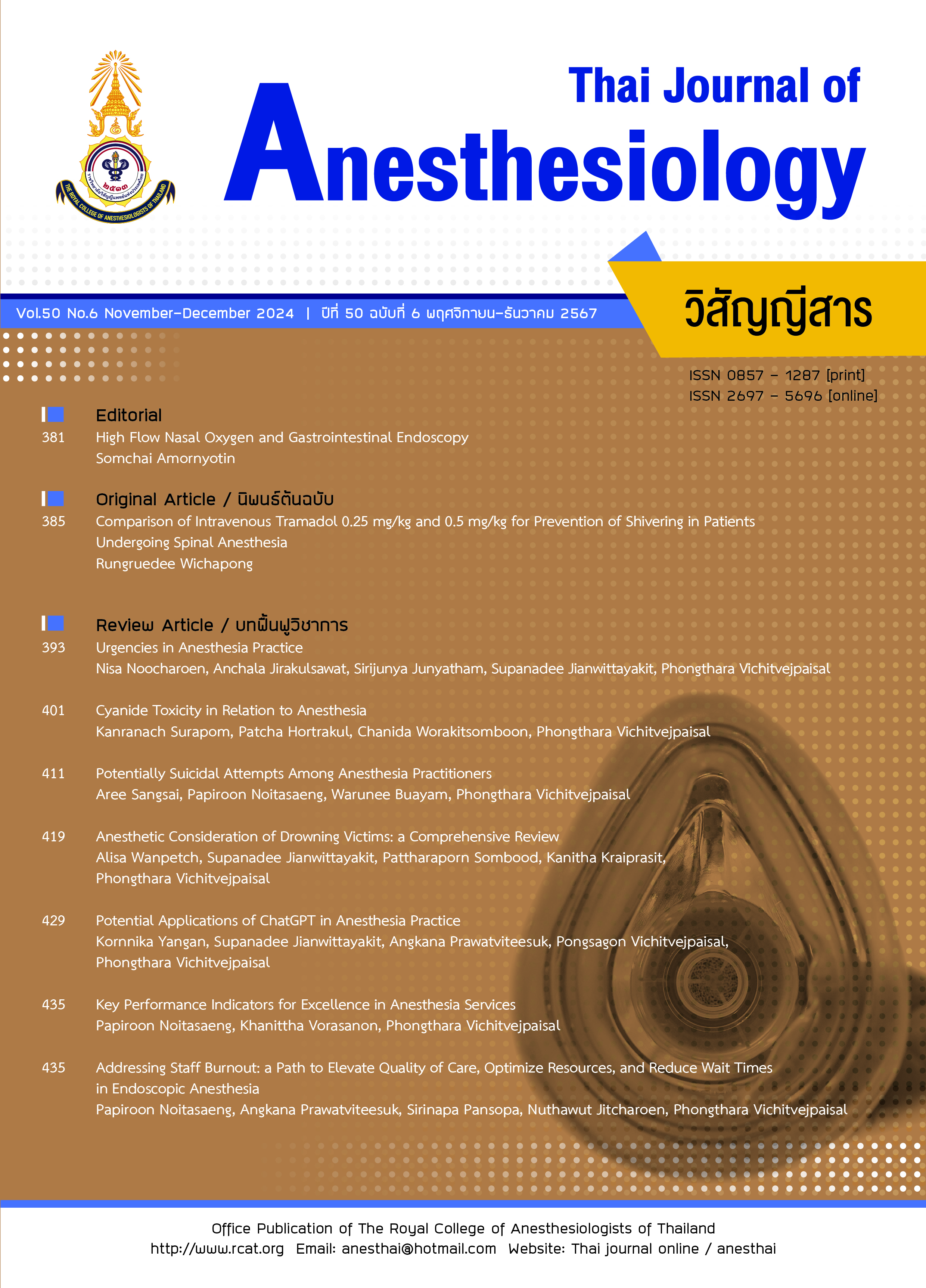2 Urgencies in Anesthesia Practice
Main Article Content
Abstract
Anesthesia urgencies are critical events that demand rapid and precise interventions to ensure patient safety and optimal outcomes. This article comprehensively explores the diverse landscape of anesthesia urgencies, categorizing them into hemodynamic instability, respiratory compromise, anaphylaxis and allergies, neurological emergencies, and malignant hyperthermia. Strategies for immediate response protocols, tailored management, and vigilant monitoring are elucidated, emphasizing the critical role of teamwork and preparedness. The significance of patient-related factors, anesthetic agent selection, monitoring techniques, and preoperative assessment is highlighted in preventing urgencies.
Article Details

This work is licensed under a Creative Commons Attribution-NonCommercial-NoDerivatives 4.0 International License.
References
Jameson K. Surgical techniques and strategies: integrating anesthesia in general surgery. Indus J Med Health Sci. 2023;1:112-36.
Meyer S. Monitoring the anesthetized patient. In: Carroll C, ed. Anesthesia and pain management for veterinary nurses and technician. New York, Teton NewMedia. 2018;p3-119.
Indra I, Kulsum K. Pre-anesthesia assessment and preparation. Budapest Int Res Exact Sci (BirEx) J. 2020;2:228-35.
Dewachter P, Kopac P, Laguna JJ, et al. Anaesthetic management of patients with pre-existing allergic conditions: a narrative review. Br J Anaesth. 2019;123:e65-81.
Checketts MR, Alladi R, Ferguson K, et al. Recommendations for standards of monitoring during anaesthesia and recovery 2015: association of anaesthetists of Great Britain and Ireland. Anaesthesia. 2016;71:85-93.
De Simone B, Kluger Y, Moore EE, et al. The new timing in acute care surgery (new TACS) classification: a WSES Delphi consensus study. World J Emerg Surg. 2023;18:32.
Xu F, Han L, Wang Y, et al. Prolonged anesthesia induces neuroinflammation and complement-mediated microglial synaptic elimination involved in neurocognitive dysfunction and anxiety-like behaviors. BMC Med. 2023;21:7.
Lawton TO, Quinn A, Fletcher SJ. Perioperative metabolic acidosis: the Bradford Anaesthetic Department Acidosis Study. J Intensive Care Soc. 2019;20:11-7.
Kim JY, Khavanin N, Rambachan A, et al. Surgical duration and risk of venous thromboembolism. JAMA Surg. 2015;150:110-7.
Wongswadiwat M, Sriraj W, Ratanasuwan P, Prakarnkamanant D, Uppan K, Polsena L. Incident related to anesthesia at tertiary care university hospital. Srinagarind Med J. 2018;4:308-13.
Magoon R, Makhija N, Das D. Perioperative myocardial injury and infarction following non-cardiac surgery: a review of the eclipsed epidemic. Saudi J Anaesth. 2020;14:91-9.
Smilowitz NR, Berger JS. Perioperative cardiovascular risk assessment and management for noncardiac surgery: a review. JAMA. 2020;324:279-90.
VanDyck TJ, Pinsky MR. Hemodynamic monitoring in cardiogenic shock. Curr Opin Crit Care. 2021;27:454-9.
Puelacher C, Lurati-Buse G, Singeisen H, Dang M, Cuculi F, Müller C. Perioperative myocardial infarction/injury after noncardiac surgery. Swiss Med Wkly. 2015;145:w14219.
Hojo T, Kimura Y, Shibuya M, Fujisawa T. Predictors of hypotension during anesthesia induction in patients with hypertension on medication: a retrospective observational study. BMC Anesthesiol. 2022;22:343.
Yancey R. Anesthetic management of the hypertensive patient: part II. Anesth Prog. 2018;65:206-13.
Frampton J, Ortengren AR, Zeitler EP. Arrhythmias after acute myocardial infarction. Yale J Biol Med. 2023;96:83-94.
Sarkar M, Niranjan N, Banyal PK. Mechanisms of hypoxemia. Lung India. 2017;34:47-60.
Jeffrey L, Carin A, Richard T, et al. 2022 American society of anesthesiologists practice guidelines for management of the difficult airway. Anesthesiology. 2022;136:31-81.
Pflipsen MC, Colon KMV. Anaphylaxis: recognition and management. Am Fam Physician. 2020;102:355-62.
Antel R, Ingelmo P. Local anesthetic systemic toxicity. CMAJ. 2022;194:E1288.
Macfarlane AJR, Gitman M, Bornstein KJ, El-Boghdadly K, Weinberg G. Updates in our understanding of local anaesthetic systemic toxicity: a narrative review. Anaesthesia. 2021;76:27-39.
Galizia EC, Faulkner HJ. Seizures and epilepsy in the acute medical setting: presentation and management. Clin Med. 2018;18:409-13.
Hopkins PM, Girard T, Dalay S, et al. Malignant hyperthermia 2020: guideline from the Association of Anaesthetists. Anaesthesia. 2021;76:655-64.
Gaba DM. Anaesthesiology as a model for patient safety in health care. BMJ. 2000;320:785-8.
Liu LL, Larson MD. Patient safety during anesthesia: 100 years of progress documented in anesthesia & analgesia. Anesth Analg. 2022;135(Suppl1):S37-47.
David M, Kevin J, Steven K, Amanda R. Teaching anesthesia crisis resource management. In: David M, Kevin J, Steven K, Amanda R, eds. Crisis management in anesthesiology, 2nd ed. Philadelphia: Elsevier Inc. 2015;p54-64.
Simmons WR, Huang J. Operating room emergency manuals improve patient safety: a systemic review. Cureus. 2019;11:e4888.


